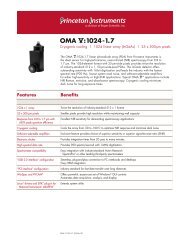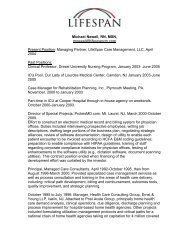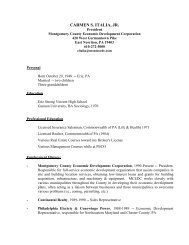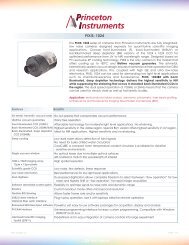Diffraction Grating Handbook
Diffraction Grating Handbook
Diffraction Grating Handbook
Create successful ePaper yourself
Turn your PDF publications into a flip-book with our unique Google optimized e-Paper software.
15. HANDLING GRATINGS<br />
A diffraction grating is a first surface optic, so its surface cannot be<br />
touched or otherwise come in contact with another object without damaging it<br />
and perhaps affecting its performance. Damage can take the form of<br />
contamination (as in the adherence of finger oils) or distortion of the microscopic<br />
groove profile in the region of contact. This chapter describes the reasons why a<br />
grating must be handled carefully and provides guidelines for doing so.<br />
15.1. THE GRATING SURFACE<br />
Commercially available diffraction gratings are replicated optics comprised of<br />
three layers: a substrate, a resin layer, and (usually) a reflective coating (see<br />
Chapter 5). Each layer serves a different purpose: (1) the metallic layer provides<br />
high reflectivity, (2) the resin layer holds the groove pattern and groove profile,<br />
and (3) the substrate (usually glass) keeps the optical surface rigid.<br />
15.2. PROTECTIVE COATINGS<br />
Since the groove profile is maintained by the resin layer, rather than the<br />
reflective (metallic) coating on top of it, protective coatings such as those that<br />
meet the military specification MIL-M-13508 (regarding first-surface aluminum<br />
mirrors) do not serve their intended purpose. Even if the aluminum coating itself<br />
were to be well-protected against contact damage, it is too thin to protect the<br />
softer resin layer underneath it. “Fully cured" resin is not very hard, resembling<br />
modeling clay in its resistance to contact damage. Consequently gratings are not<br />
provided with contact-protecting coatings.<br />
223
epoxy<br />
substrate<br />
aluminum<br />
Figure 15-1. Composition of a replica diffraction grating. A section of a standard blazed<br />
grating with an aluminum coating is shown. Layer thicknesses are not shown to scale:<br />
generally the aluminum film thickness is about 1 μm, and the resin layer is between 10<br />
and 50 μm, depending on groove depth and grating size; the substrate thickness is usually<br />
between 3 and 100 mm.<br />
15.3. GRATING COSMETICS AND PERFORMANCE<br />
Warnings against touching the grating surface notwithstanding, damage to<br />
the surface occasionally occurs. Contact from handling, mounting or packaging<br />
can leave permanent visible marks on the grating surface. Moreover, some<br />
gratings have cosmetic defects that do not adversely impair the optical<br />
performance, or perhaps represent the best available quality for a grating with a<br />
particular set of specifications. For example, some gratings have 'worm tracks'<br />
due to mechanical ruling of the master grating from which the replicated grating<br />
was taken, others have coating defects like spit or spatter, and others have<br />
'pinholes' (tiny voids in the reflective coating), etc. The many possible<br />
classifications of surface defects and the many opportunities to render the<br />
surface permanently damaged conspire to make the surfaces of many gratings<br />
look less than cosmetically perfect.<br />
While this damage may be apparent upon looking that the grating, it is not<br />
straightforward to determine the effect this damage has on the performance of<br />
the grating. Often the area affected by damage or contamination is a small<br />
fraction of the total area of the grating. Therefore, only a small portion of the<br />
224
total number of grooves under illumination may be damaged, displaced or<br />
contaminated. A damaged or contaminated region on the surface of a grating<br />
may have little, if any, noticeable effect on the performance of the optical system,<br />
because a diffraction grating is usually used as an integrating optic (meaning<br />
that all light of a given wavelength diffracted from the grating surface is brought<br />
to focus in the spectral order of interest). In contrast, a lens or mirror that does<br />
not focus (say, an eyeglass lens or a bathroom mirror) will show a distortion in its<br />
image corresponding to the damaged region of the optic. This familiar experience<br />
– the annoying effect of a chip on an eyeglass lens or a smudge on a bathroom<br />
mirror – has led many to assume that a similar defect on the surface of a grating<br />
will lead to a similar deficiency in performance. The most appropriate<br />
performance test of a grating with surface damage or cosmetic defects is not<br />
visual inspection but instead to use the grating in its optical system and<br />
determine whether the entire system meets its specifications.<br />
Damage to a region of grooves, or their displacement, will theoretically have<br />
some effect on the efficiency of the light diffracted from that region, as well as<br />
the total resolving power of the grating, but in practice such effects are generally<br />
not noticeable. Of more concern, since it may be measurable, is the effect surface<br />
damage may have on light scattered from the grating, which may decrease the<br />
signal-to-noise (SNR) of the optical system. Most forms of surface damage can<br />
be thought of as creating scattering centers where light that should be diffracted<br />
(according to the grating equation) is scattered into other directions instead.<br />
15.4. UNDOING DAMAGE TO THE GRATING SURFACE<br />
Damage to the microscopic groove profile is, unfortunately, irreversible; the<br />
resin layer, like modeling clay, will retain a permanent imprint. Contamination of<br />
the grating surface with finger oils, moisture, vacuum pump oil, etc. is also often<br />
permanent, particularly if the contaminated grating surface has been irradiated.<br />
Sometimes surface contamination can be partially removed, and once in a<br />
while completely, using a mild unscented dishwashing liquid. Care should be<br />
taken not to apply any pressure (even gentle scrubbing) to the grating surface. If<br />
contaminants remain, try using spectroscopic-grade solvents; the purity of such<br />
solvents should be ascertained before use, and only the purest form available<br />
225
used. The use of carbon dioxide (CO 2) snow, 174 which reaches the grating<br />
surface in a sublimed state and evaporates, carrying with it the contaminants, has<br />
also been used with some success. The key to cleaning a grating surface is to<br />
provide no friction (e.g., scrubbing) that might damage the delicate groove<br />
structure.<br />
15.5. GUIDELINES FOR HANDLING GRATINGS<br />
• Never touch the grooved surface of a diffraction grating. Handle a<br />
grating by holding it by its edges. If possible, use powder-free gloves<br />
while handling gratings.<br />
• Never allow any mount or cover to come in contact with the grooved<br />
surface of a diffraction grating. A grating that will be shipped should<br />
have its surface protected with a specially-designed cover that does not<br />
touch the surface itself. <strong>Grating</strong>s that are not in use, either in the<br />
laboratory or on the manufacturing floor, should be kept in a closed box<br />
when not covered. Keep any oils that may be used to lubricate grating<br />
mount adjustments away from the front surface of the grating.<br />
• Do not talk or breathe over the grooved surface of a diffraction<br />
grating. Wear a nose and face mask when it is required that you talk<br />
over the surface of a grating. Breath spray is particularly bad for<br />
reflection gratings, so one should not speak directly over the grating<br />
surface; instead, either turn away or cover the mouth (with the hand or a<br />
surgical mask).<br />
174 R. R. Zito, “Cleaning large optics with CO2 snow,” Proc. SPIE 1236, 952-972 (1990).<br />
226

















